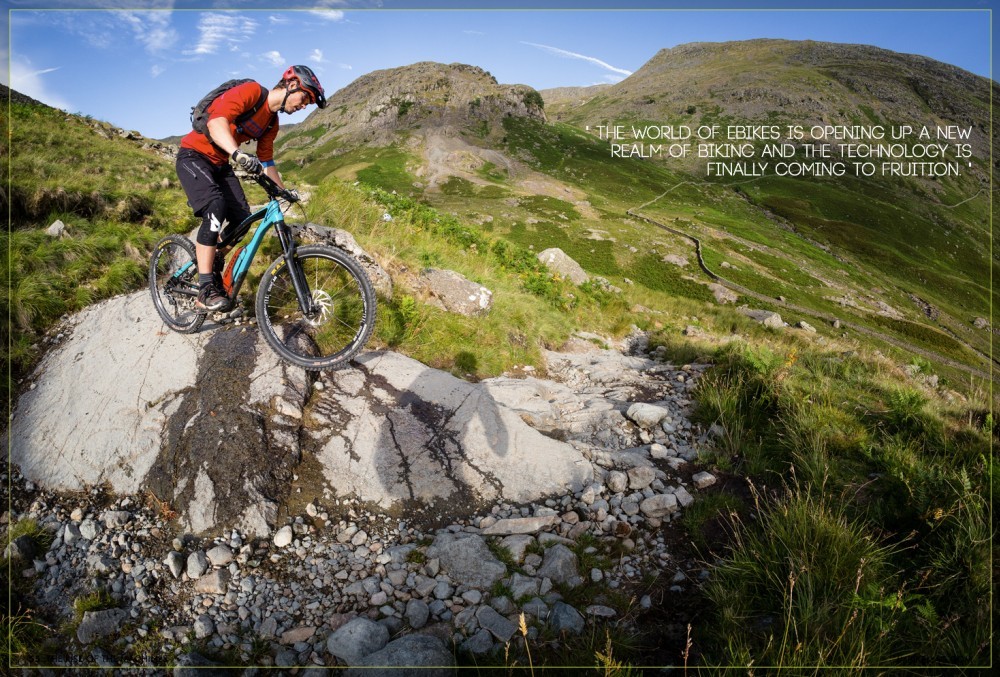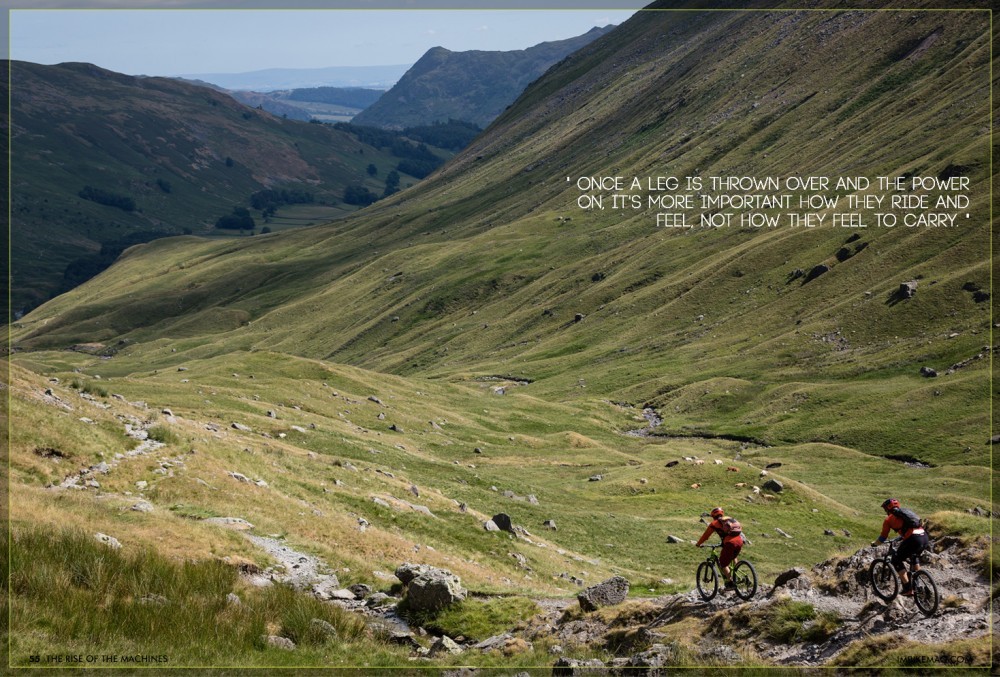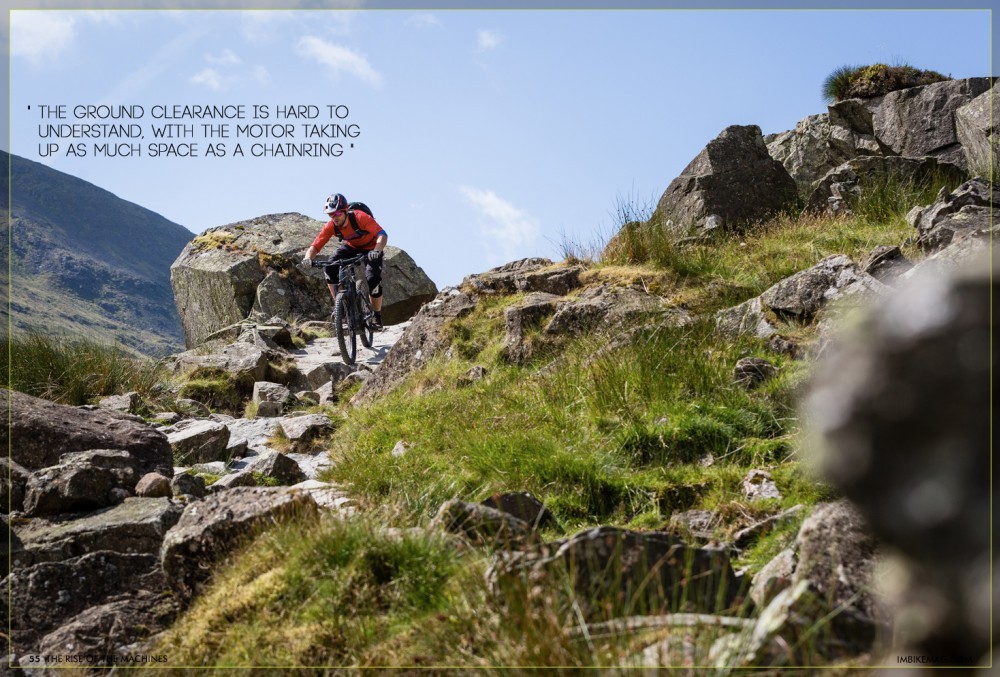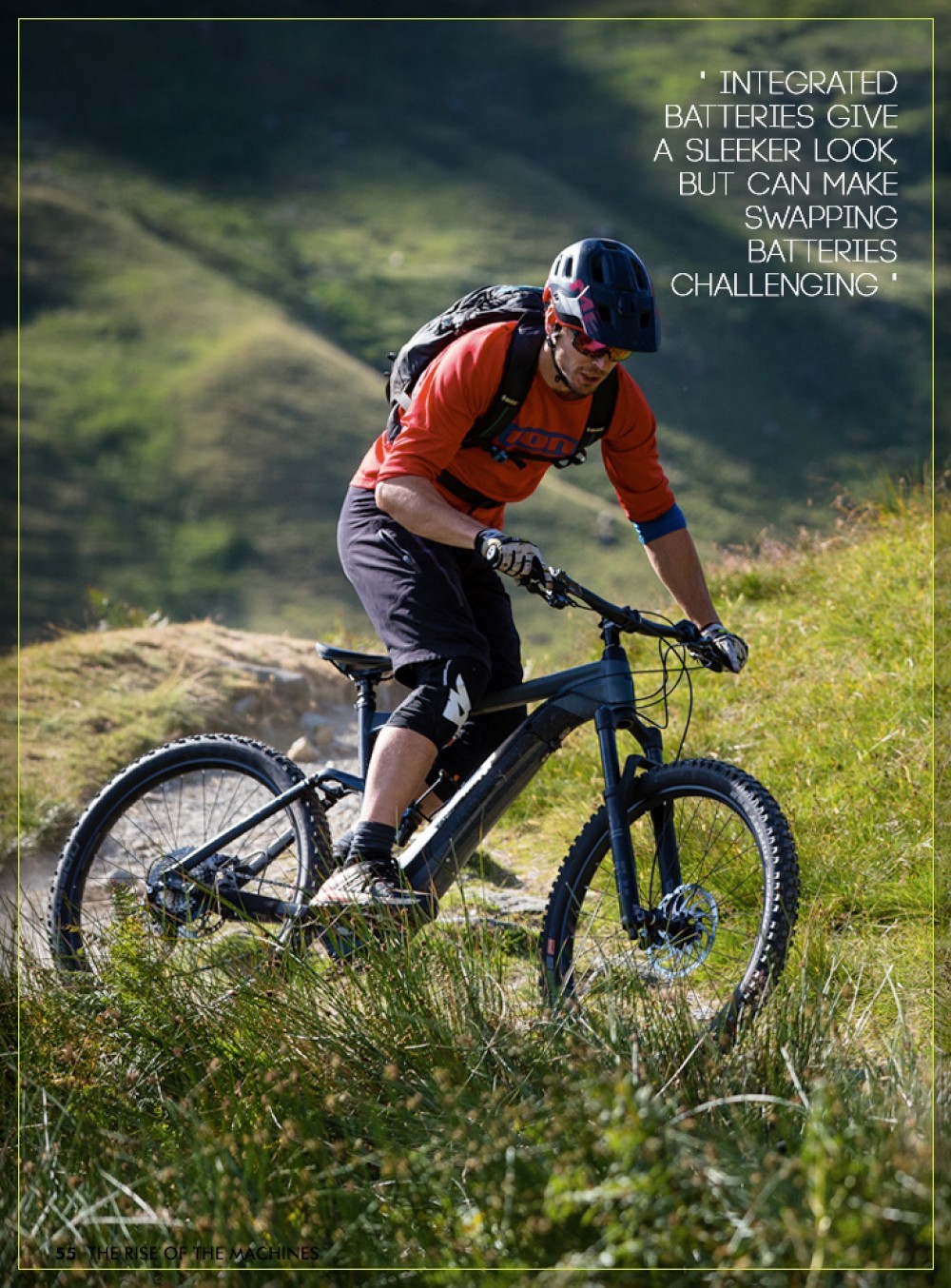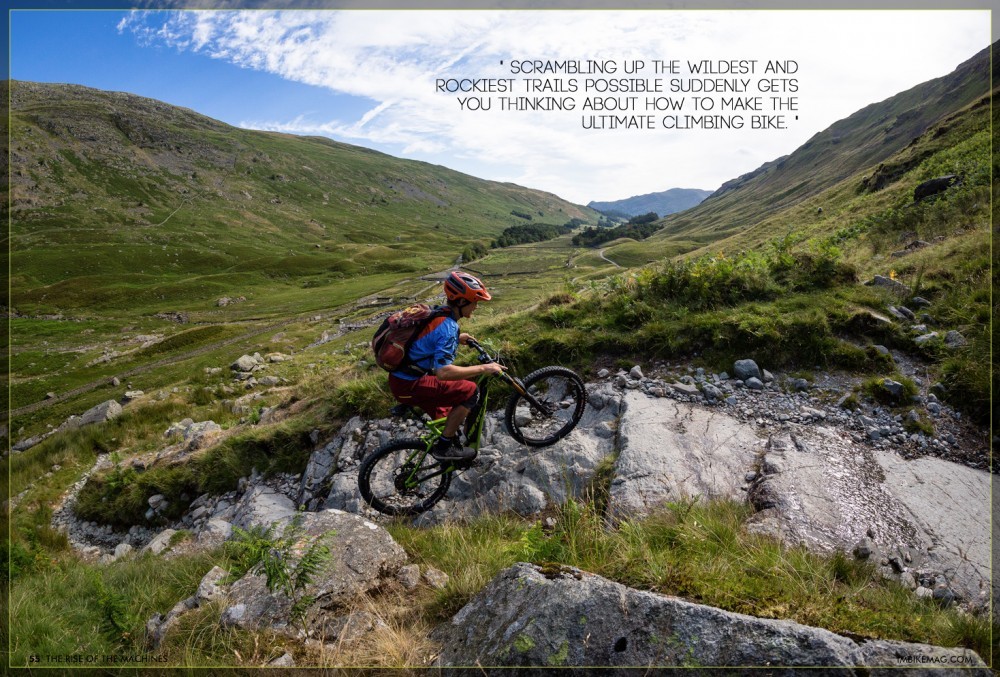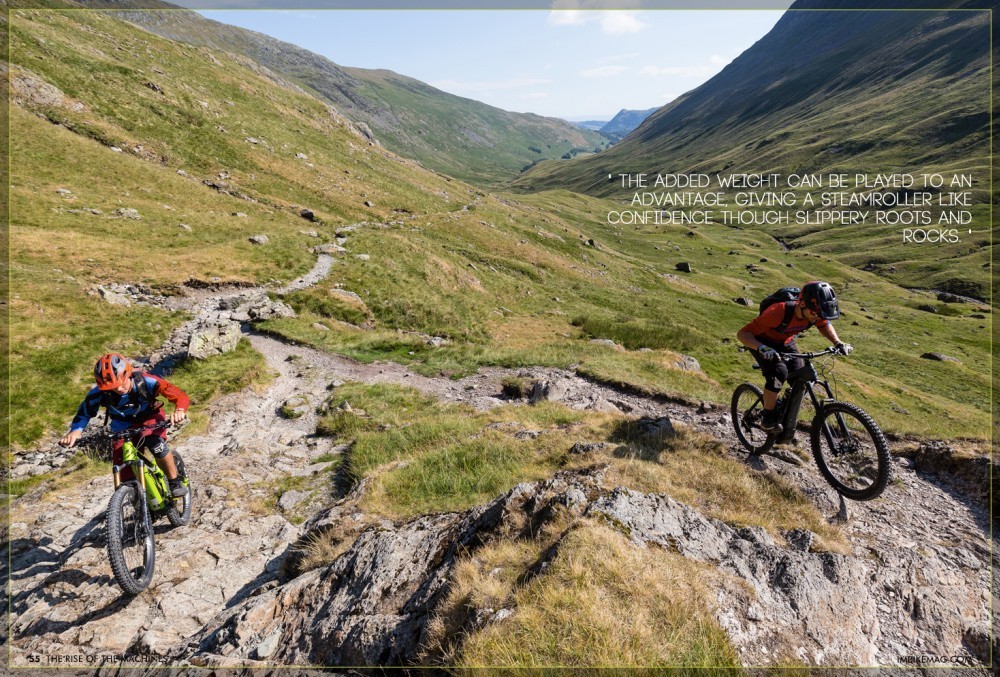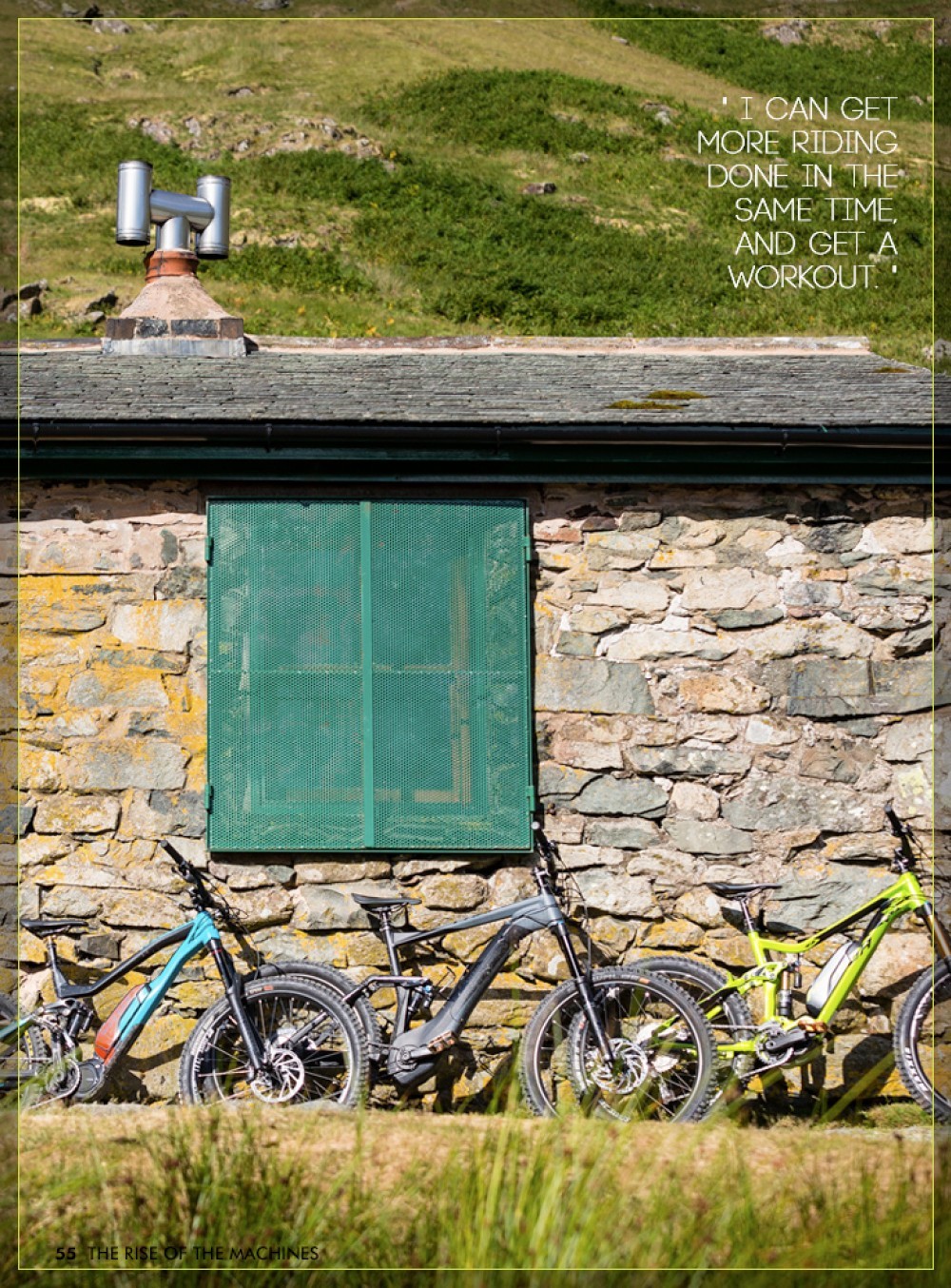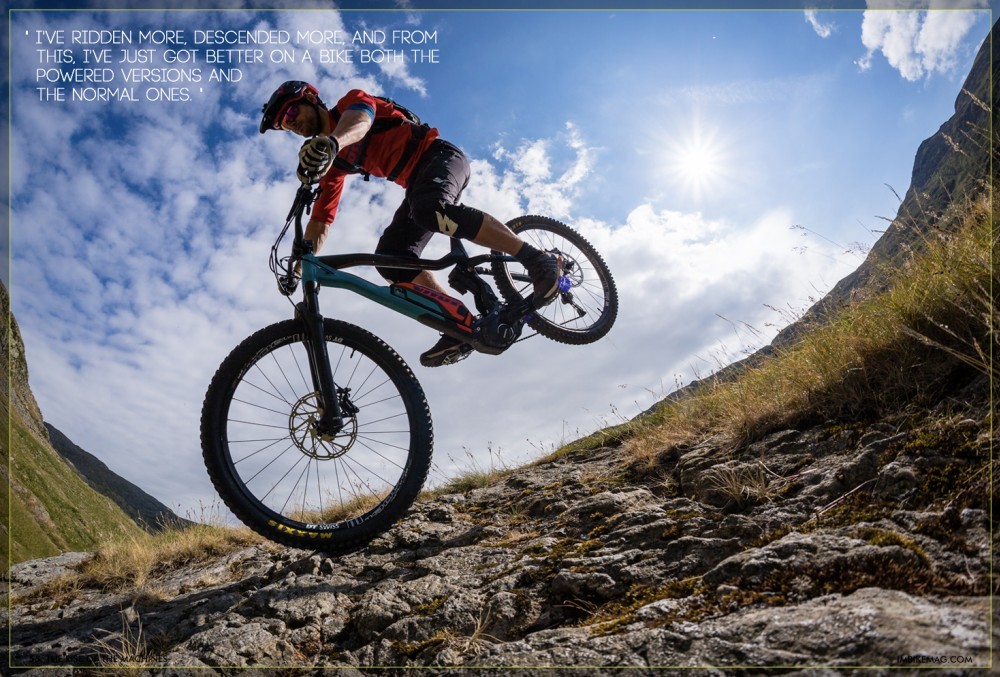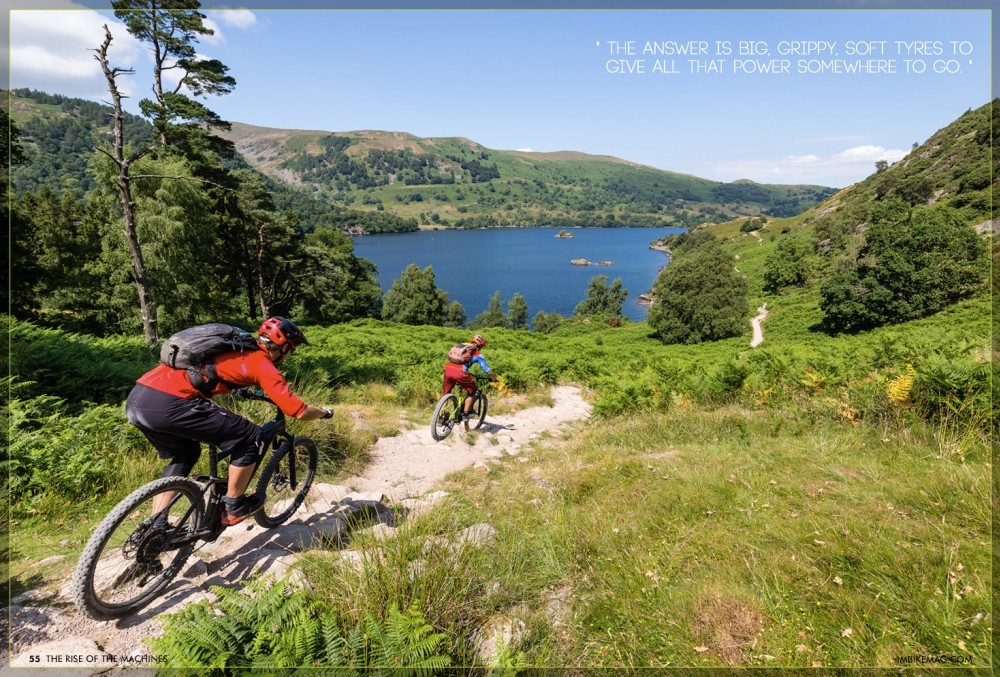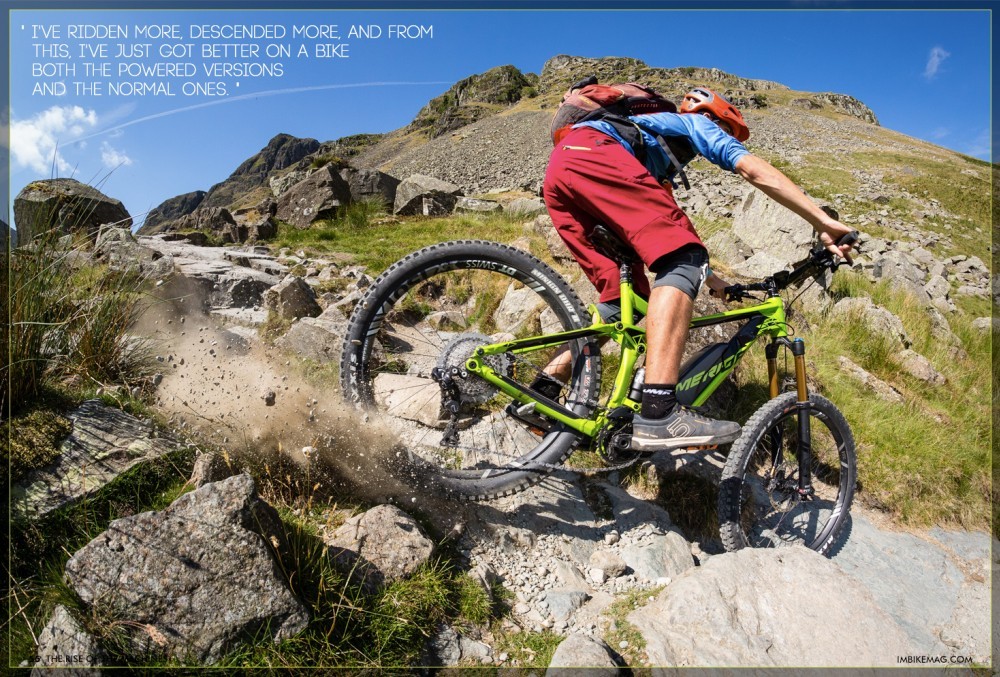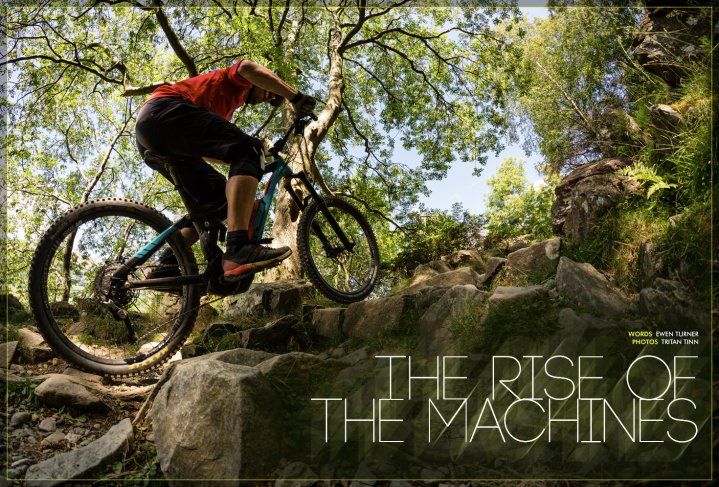
The Rise Of The Machines
Issue 55 / Wed 22nd Aug, 2018
Ebikes are here to stay and have finally got good enough to really get busy on the trails. We got our hands on the latest crop of rides and took them out into the wild to see what they could do, and find out more about these strange new beasts.
It's happened, and there is no avoiding it. The onward march of electric bikes now means that mountain bikes with batteries have finally arrived. Sure, they've been around for ages, but now, finally, we have ebikes ready to actually do what we want of them in the off-road environment. Much of the initial experimentation has happened, and the bikes are looking and performing in a way that can no longer be ignored.
Now if this opening paragraph has riled you up to a forum-ranting rage, then feel free to choose your own adventure and turn to the next article and forget this whole thing ever happened. Still with me? Good. So as a global magazine, we need to consider that for some parts of the world ebikes are accepted, allowed and encouraged, while in others, they are banned, vilified and shunned. If you live in the former, then the world of ebikes is opening up a new realm of biking and the technology is finally coming to fruition.
With the advent of quality e-mountain bikes, we found three of the best and went to see what they could really do, in proper mountains, doing proper mountain biking.
Just Like Riding a Bike
The gradual arrival of ebikes and their acceptance can be measured by a friend of mine know for not mincing his words. Twelve months ago we had the 'go buy a f**king motorbike' response, which evolved into 'can I have a go?' and finally after a ride out on one ended with, 'how much can you get one of these for?'.
The tone of this article is obviously pro-ebike, and yes, I've been won over by them, and contrary to popular opinion, I'm not fat and/or lazy. First up, you have to pedal, there is no throttle, and it'll take you to 25km/h before leaving you to it. The acceleration is powerful, depending on brand, and with minimal effort, you can be at top speed. Point up a hill and things change, as if you want to keep up to 25kmh, then you will have to dig deep and put some effort in. Sure you can sit back and twiddle the pedals, but I'm yet to ride with anyone who is happy to ride both slowly and with minimal effort up a hill.
There is a common misconception that ebikes make everyone ride really fast, but this is not entirely true. On a ride, your top speeds will not increase, as nearly any time you descend, you will be above the 25kmh limit. What will happen is that your slowest speed will increase, essentially they won't make you faster, only less slow.
Perhaps the most obvious difference from a regular bike is the weight. Just pulling one out of the van is an effort, and can instantly put people off, but once a leg is thrown over and the power on, it's more important how they ride and feel, not how they feel to carry. This additional low-slung weight is what gives them such a planted and relaxed feel on the trail, making all other mountain bikes feel skittish and nervous in comparison. Essentially it is just a bike, and they require no real adjustment to get going on them, just pedal and go.
Technology
The power systems comprise of two parts, the battery and the motor. The most popular systems use a motor based around the cranks and deliver a torque of up to 75Nm (Bosch) and 70Nm (Shimano). The amount of assistance is dictated by the rider input and the 'mode' selected, which can offer up to 300% support from the motor. Our test bikes so far have been based on the Shimano and Bosch systems, but there are many others out there.
Bosch have been making ebike motors and batteries since 2009, They wouldn't be drawn when asked if it was merely a windscreen wiper motor saying they 'draw on and pool some essential know-how from other areas the Group: the rechargeable battery technology from wireless power tools as well as electric motors, electronics and sensors from the automotive industry'.
One big difference between the big players (Shimano and Bosch) is the use of a small drive cog on Bosch and a full chainring on Shimano. In use, there is little difference, but the Bosch unit has 'an internal gear ratio of 1:2.5. This gear ratio configuration gives the CX drive unit a very dynamic and responsive riding characteristic and allows for improved ground clearance'. The ground clearance is hard to understand, with the motor taking up as much space as a chainring, but the power achieved from the system is huge with Bosch explaining 'The torque delivery of the drive unit is very linear, and the 75Nm of torque produced is maintained through the cadence range of the drive unit'. On the trail, it's clear that Bosch has some serious power throughout the range.
Shimano's motor aims to provide a more 'natural feeling, with responsive and customisable support' and certainly give the feeling of increased fitness rather than a turbo booster. The E8000 system also is more compact and has a lower Q factor (the width between pedals).
Most ebike systems now take software updates and are Bluetooth compatible. Bosch recently updated their motors to include eMTB mode, which automatically changes the input based on the rider's power, making traction easier and simplifying the controls for the rider. Bosch also adds that 'new features for the model year 2019 include stronger walk assistance for steep and unpaved roads and new software for short cranks, which offers more ground clearance on trails'.
Shimano's Etube app can connect to the system and customise power outputs and diagnose faults in the system. They also have released their new E7000 system, which offers 'Affordability, customisation of controls and noise reduction' although this is for light duties rather than full off-road.
Batteries are generally in the 500Wh range and can be either integrated into the frame, or external. Integrated batteries give a sleeker look, but can make swapping batteries challenging. External batteries are also easier to remove to charge away from the bike. The next few years will see rapid development in this area, as electric cars develop a pace and the technology will inevitably expand.
It's clear that the arms race is on with additional technology, and the next versions of eMTBs will undoubtedly be competing on battery size, range and weight. Currently, there is little to choose between them, but they do offer subtly different experiences.
Intelligent Design
The majority of eMTBs can be divided into two categories; those bikes designed purely to be an ebike, and conventional bikes that have had a motor attached. While some brands started from scratch to create the best ebike, others have simply taken an existing bike and slipped in the new technology.
For those new to riding electric bikes, bikes based on existing models work very well as they feel familiar. Long reach, short chainstays and low bottom brackets all work well on conventional bikes and therefore work pretty well on an ebike, but it's not that simple. If you merely want to electrify your local trail centre loop, then that is perfect, but what If you want to take ebikes to the next level.
Climbing is where eMTBs come alive, and really show what they are capable of. They don't make you faster on the descents, but on the climbs, well that's another story. Scrambling up the wildest and rockiest trails possible suddenly gets you thinking about how to make the ultimate climbing bike. Take the Cube Stereo for example, with huge 470mm chainstays, suddenly front wheel lift is eliminated and traction maintained. A low bottom bracket is great for descending ability, but what about pedal strikes, while pedalling hard to keep the motor pushing. What if cranks were as short as possible, with the extra power the leverage loss is not an issue, but the clearance is again improved.
As yet, I haven't experienced the perfect balance on an ebike, which can combine climbing prowess with descending ability, but then that's the Holy Grail for most mountain bikes. As a consumer, a question must be asked about what you want to get from the eMTB, and whether all out climbing ability is crucial for you.
Recently, the battle to integrate batteries has been a major feature, but for me, the ability to swap out batteries is crucial for long rides and outweighs any visual aesthetic.
Electric Performance
Ebikes do many things well, not least climbing, but they always surprise me with what they are capable of. Climbing on ebikes is an engaging, technically exacting and exhausting affair, and has ended up being a focus of my rides. Trails previously avoided due to relentless technical and powerful climbing have seen renewed attention and developing the specific skills required to ride them has been awesome. Learning to ride uphill, while employing descending techniques has been key, looking far ahead, dropping my seat and managing momentum. Not only that, it has got me better at riding my bikes, with or without power.
Descending is an entirely new experience, with the low weight keeping the bike tracking and glued to the floor. They calm down the rockiest and loose descents and make a huge amount of sense in these situations; I can see why downhill racers may experiment with weighted bikes! Even on slow technical sections, the added weight can be played to an advantage, giving a steamroller like confidence though slippery roots and rocks.
The added weight certainly gives a workout and building the strength required to hop the bike has certainly improved my all-around fitness, something I hadn't thought of previously. A long descent on rocky terrain leaves you aching from muscling the bike around, but on return to a normal bike, it feels as light and manoeuvrable as a feather.
It's easy to just dismiss ebikes as lazy, but all they do is add to your fitness, not take anything away. I've found that I've used them for either short blasts or huge epics. With time being tight in an evening, I can get more riding done in the same time, and get a workout. With more time and a couple of batteries, the distances open up, and maps can be crossed with ease. What is worth remembering is that carrying an ebike is not an experience to be repeated if possible and if you do get a mechanical, you'll be a lot further from home than usual!
The range is hugely variable and depends on power mode, terrain, rolling resistance and even temperature. I find I can get 800 to 1200m of ascent from a battery, and this is a better measure rather than distance. On Eco mode on the flat, the distance is huge, but that's not mountain biking. Two batteries for me is the answer and is crucial to get the most out of a proper electric mountain bike.
With all this riding of ebikes, the result has been an improvement in my riding. I've ridden more, descended more, and from this, I've just got better on a bike both the powered versions and the normal ones. The added weight has forced a different style and improved my strength and core stability on the bike. If I were training for racing, then I'd certainly spend plenty of time on an eMTB to get the laps in.
The Ideal Bike
So the ideal ebike, that's a tricky one, but time spent on so many has drawn some conclusions. Firstly, hardtail ebikes for proper riding are not great, in fact, they can feel pretty awful. The additional weight through a stiff back end is very unforgiving and harsh. In addition, to keep the power on, the pedals need to keep turning, and that is easiest to do while sat down, which is not so comfy on a hardtail on the rough stuff. So full suspension is key to good performance, but not only that, long travel is the way to go, and why not? With the weight penalties null and void, just go big! If the budget can stretch, then higher quality suspension makes a huge difference, and an ebike floating on well-damped suspension rides both smooth and feels light.
Geometry needs to reflect the end purpose, and although long chainstays and short cranks will get you uphill, the balance in performance needs to be found. In terms of components, again, bigger is better. Big brakes, big wide bars and big tyres are crucial. Plus-sized tyres so far just can't take the abuse, and so downhill casing tyres are the answer, or definitely Double Down, Super Gravity options (other tyre casings are available). Many eMTBs turn up with hard-41wearing rear tyres, which may work for the wallet, but fail to get any grip in a car park, let alone some ugly rocky climb. So the answer is big, grippy, soft tyres to give all that power somewhere to go.
Overall, bigger and stronger is better, so no skimping on weight as parts need to survive the extra beating and the extra miles you'll put in. Ebike specific components are coming through thick and fast, but the kit is already there in the form of enduro and downhill components such as tyres and brakes. Finally, for me, the ideal ebike has easy to remove batteries, which are small enough to fit in a pack for big trips, Shimanos batteries are ideal for this. At about £500, a second battery is essential if you want to get into the mountains properly and worth budgeting for.
The Future
The eMTB world is not without its challenges. Access around the world varies greatly, and they could threaten access in certain areas where even standard bicycles are not welcome. It's crucial that riders understand where and when they can ride them, and ride in a socially and environmentally responsible way.
The additional erosion is often cited as an issue, but on the ground, they cause similar damage to a standard bike. If the ground is wet, then sure, they can churn up the mud in ascent, but traction soon runs out and getting started again is a thankless task, so I doubt we will see swathes of ebikers smashing up the hillsides, it's just not much fun. What they do allow is for riders to cover more ground and therefore more miles ridden, and more erosion per person, per week.
Challenges for riders also include maintenance and support. As yet I haven't got a clue how to strip down a motor, and any trailside fixes beyond 'switch it off and on again' are unknown to me.
Providing access is appropriate, ebikes offer yet another way to enjoy bikes and mountains. From the time-pressured rider who wants to get as much descending in as possible, to those who physically need some assistance, they are just another solution. For me, I still need a 'normal' bike, but if money were no object, there would definitely be an ebike in the garage.
Thanks to Cube, Vitus, Merida, Bosch and Shimano
Videos
By Ewen Turner
Ewen Turner is a self-confessed bike geek from Kendal in the Lake District of England. He runs a coaching and guiding business up there and has a plethora of knowledge about bikes with an analytical approach to testing. His passion for bicycles is infectious, and he’s a ripper on the trails who prefers to fit his working life around his time on the bike.



